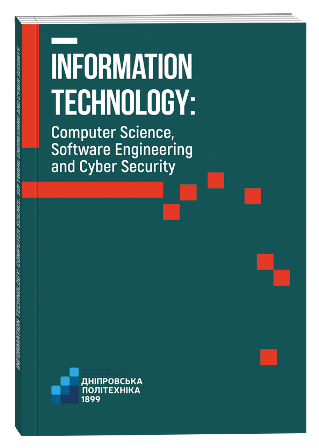EVALUATION OF THE EFFECTIVENESS OF USING CONVOLUTIONAL AND RECURRENT NEURAL NETWORKS IN THE TASK OF TEXT DATA PROCESSING
DOI:
https://doi.org/10.32782/IT/2023-2-5Keywords:
classification, CNN, RNN, efficiency, neural networks.Abstract
This work is dedicated to evaluating the effectiveness of using convolutional and recurrent neural networks in the task of processing textual data, specifically in detecting fake news. Currently, the efforts of the global community are focused on combating such misinformation as a whole, which underscores the relevance of the addressed issue. The problem of detecting fake news lies in accurately determining the authenticity of the information. The objective of this work is to compare the accuracy of identifying fake news between convolutional and recurrent neural network architectures, which incorporate a syntactic analysis model of article texts by forming news labels using TF-IDF and Word Embedding. To achieve this goal, an analysis of the application domain was conducted, and the key characteristics of this type of information were identified. The theoretical foundation of the selected architectures was examined, and their configurations were established in accordance with the defined task. An experimental environment was created for the practical implementation of the chosen types of neural networks. The relative effectiveness of using recurrent neural networks compared to convolutional ones was revealed, and potential scenarios were identified where the obtained results may vary. As a result of the analysis, it was determined that the convolutional neural network performs computations faster than the recurrent neural network on the available data, but it provides less accurate classification results. Taking into account the proposed rule for performance comparison, the marginal increase in productivity can be considered insignificant, considering the probabilities of different types of errors and the potential for resolving discrepancies between algorithms. This conclusion aligns with the global scientific practice, which recommends using one of the proposed models or their combination for analyzing textual information, particularly when dealing with two classes (fake and non-fake data) or verifying the authenticity of images.
References
Fake News. Cambridge Dictionary. URL: https://dictionary.cambridge.org/dictionary/english/fake-news (дата звернення: 05.04.2023).
Wesolowski K. Fake news further fogs Russia’s war on Ukraine. Deutsche Welle. URL: https:// www.dw.com/en/fact-check-fake-news-thrives-amid-russia-ukraine-war/a-61477502 (дата звернення: 08.04.2023).
Twitter steps up Ukraine misinformation fight. BBC News. URL: https://www.bbc.com/news/ business-61512261 (дата звернення: 08.04.2023).
Hybrid Warfare Analytical Group. How russian disinformation works in Telegram. Ukraine Crisis Media Center. URL: https://uacrisis.org/en/ros-dezinfo-telegram (дата звернення: 08.04.2023).
Blocman A. Laws to combat manipulation of information finally adopted. IRIS Merlin. URL: https://merlin. obs.coe.int/article/8446 (дата звернення: 09.04.2023).
Danzig J. How fake news caused Brexit. UACES. URL: https://europe.ideasoneurope.eu/2017/11/14/ fake-news-caused-brexit/ (дата звернення: 09.04.2023).
Про внесення змiн до статтi 259 Кримiнального кодексу України щодо посилення вiдповiдальностi за завiдомо неправдиве повiдомлення про загрозу безпецi громадян : Закон України вiд 02.03.2021 р. № 1292-IX. URL: https://zakon.rada.gov.ua/laws/show/1292-20 (дата звернення: 09.04.2023).
Classifying Fake News Detection Using SVM, Naive Bayes and LSTM / P. Jain та iн. 2022 12th International Conference on Cloud Computing, Data Science & Engineering, м. Noida, 27–28 сiч. 2022 р. URL: https://doi.org/10.1109/Confluence52989.2022.9734129 (дата звернення: 20.04.2023).
A Study on Fake News Detection Using Naive Bayes, SVM, Neural Networks and LSTM / P. S. Reddy та iн. Journal of Advanced Research in Dynamical and Control Systems. 2019. Т. 11, № 06. С. 942–947.
Pai A. CNN vs. RNN vs. ANN – Analyzing 3 Types of Neural Networks in Deep Learning. Analytics Vidhya. URL: https://www.analyticsvidhya.com/blog/2020/02/cnn-vs-rnn-vs-mlp-analyzing-3-types-of-neuralnetworks- in-deep-learning/ (дата звернення: 02.05.2023).
Stecanella B. Understanding TF-ID: A Simple Introduction. Monkey Learn. URL: https:// monkeylearn.com/blog/what-is-tf-idf/ (дата звернення: 08.09.2023).
Pennington J., Socher R., Manning C. D. GloVe: Global Vectors for Word Representation. Stanford Edu. URL: https://nlp.stanford.edu/projects/glove/ (дата звернення: 15.05.2023).
Risdal M. Getting Real about Fake News. kaggle. URL: https://www.kaggle.com/datasets/mrisdal/fakenews (дата звернення: 16.05.2023). 14. Lying words: Predicting deception from linguistic styles. / M. L. Newman та iн. Personality and social psychology bulletin. 2003. Т. 29, № 5. С. 665–675.
IBM Cloud Education. Natural Language Processing (NLP). IBM Cloud Learn Hub. URL: https:// www.ibm.com/cloud/learn/natural-language-processing (дата звернення: 20.05.2023).
DS-Pr1nce. War in Ukraine: Russian social network discussions. kaggle. URL: https://www.kaggle.com/ datasets/ustyk5/war-in-ukraine-russian-social-network-discussions (дата звернення: 25.05.2023).
Dedhia R. Fake News. kaggle. URL: https://www.kaggle.com/datasets/ronikdedhia/fake-news (дата звернення: 02.06.2023).
Alecu F. The Pareto Principle in the Modern Economy. Economics of Knowledge. 2010. Т. 2, № 3. С. 2–5.
Saran A. Text Classification – CNN with LSTM. Medium. URL: https://anandsarank.medium.com/cnnwith- lstm-for-text-classification-53d18e5f7f5c (дата звернення: 11.06.2023).







